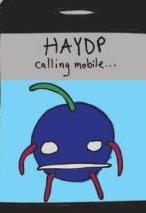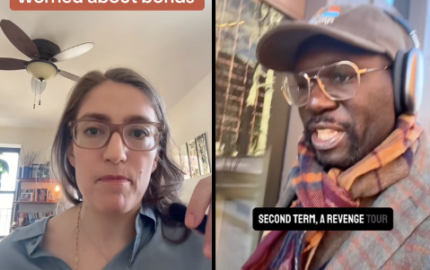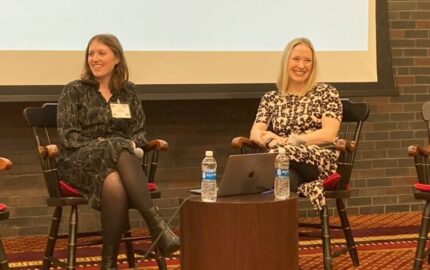 How would you categorize How Are You Doing?
How would you categorize How Are You Doing?I would call the How Are You Doing project an audio art project. There’s a lot of technical elements, and some sound mixing you don’t usually hear in regular radio—whatever that is. But also I think it’s an art project that considers how we talk to each other on a daily basis. There’s a magic and beauty in small talk. In that way this project also brings to the fore things that you otherwise wouldn’t consider special until you sit down, listen and think about them.
How long have you been doing it?
It’s actually going to be the year anniversary on February 13th. So, one year.
How did you come up with the idea for the project?
Last year I was a senior in college and had just started working in an office environment and got into being a small talker in earnest. It occurred to me how much of our days are small talk and how rarely we really sit down to listen to one another. I remember one day I particularly didn’t feel like going to work, looking in the mirror and thinking, “If someone were to ask me how I were doing today, I would totally shut them down. I wouldn’t feel like listening to them or saying anything to them that was meaningful.” And then I really started thinking about “How are you doing?” as more than a filler phrase.
That night, I came home and realized it would be easy to set up one of these toll-free hotlines. So I had the idea and set it up in the course of a day.
Does it have any funding, or is it just you?
It’s me. Briefly, for the first month, my parents were my angel investors. They gave me $25. But I fund it myself. I pay $26 a month for the hotline.
I see you have a donate button. Has anyone donated yet?
Not yet—that’s very new. The Web site redesign just launched on Sunday, so no one has donated. But they can if they want to!
How do people find the How Are You Doing number?
Initially, it was word of mouth. I made a bunch of stickers. I used to live in Chicago, and I remember on Valentine’s Day 2009, I went around and stuck stickers in bathrooms and bars and restaurants. That was my initial guerrilla marketing, and I do still get calls from those numbers sometimes. But primarily people find the project from StumbleUpon. It’s really active there, and many people come across it by chance. It’s usually a lot of young people, both men and women, mostly university students. That’s the primary referral area to the site.
On the site, you call it art—do you see it as journalism, too? You studied journalism, right?
I studied journalism at Medill, at Northwestern. When I think of journalism, I think that it’s something that’s rooted in truth—at least I hope. In that sense, the How Are You Doing project is as truthful as it gets. It’s something that we can all relate to, and all these calls, as far as I can tell, are people who are taking the question seriously. In that sense I would call it journalism.
But I think that just because the question is lifted so far away from reality, from how we actually ask each other, it moves away from being a journalistic or documentary project.
The stories sound very intimate and mundane in ways that would be hard to make up, but there’s no way of knowing if the stories are true, is there?
I guess there is no way to really get to the bottom of whether it’s “truthy,” whether this is the truth. But I like to think that people are actually talking about their days. Even if people are making up some of the calls, the ones I pick are the ones that from my own subjective view ring especially true in the day-to-day situation.
If someone did make it up, there’s truth in the fabrication—them feeling that they need to come up with a good response to that question. I feel like that’s the other side of the coin for responding to the question—you either shut people down and move on or you feel like you need to explain yourself in a way you’re not usually asked to.
It’s not like they’re online and they press a button and enter in something to make sure they’re not a robot. In order to go to the trouble of responding, there are multiple levels of engagement. Hopefully they’re listening and seeing the site. Then they have to enter the information into their phone and make the call. I’d like to think those extra hurdles help make sure they're taking the project seriously.
While digital media is opening up new approaches to narrative, many people think that some kind of shaping, in the form of editing or curation, is still required to create stories. How much thought do you give to story structure and narrative when you assemble an episode?
In terms of a call-by-call basis, I really try to avoid editing within the call. With some exceptions for really big time issues, pretty much all of them that you’ll hear are presented as they are on the hotline. What I do really consider is how the calls are placed next to each other—the arc that listeners are brought through as they listen to a given episode.
A good example of that is the Thanksgiving episode—I got such a wide variety of calls. I didn’t stick to the chronology of when they came in. There were so many people calling in and so many different experiences. I really wanted to drive that point home. If you listen to the calls, it’s a happy one and a sad one, somebody in a particular position and then someone in a totally opposite place.
That’s the extent of the editing I really consider, the way the stories are presented, but that’s a huge part of it. If I didn’t edit it, I if didn’t consider what was going into the podcast, it would just be an exercise in people checking the voice mail I listen to. So, I think in that way, and in the calls that I choose, that’s a huge curatorial effort for me. What I’m looking for are things that ring true. Whether they’re fake stories or true, the stories that we tell over and over again. And the ones that are really special are the ones that make you think of the person as a person rather than just someone answering a prompt in a really flat way.
What would you say to someone who suggests this project joins Twitter as and Facebook as fetishizing mundane life—what people ate for breakfast, what they’re watching on TV? Why do these things matter?
I think that it's the medium that’s important with the How Are You Doing project. Hearing the voices, having a one-to-one relationship with the caller. I understand the similarities with Twitter and Facebook: you’re posting something for potentially the whole world to see or hear. But I think there is something so much more personal about a phone call, about really taking the time to talk it out, to process.
It’s what I said earlier. It’s not like people are just answering these questions by clicking on a button on a comment box. A lot of times when you listen to these calls, you can hear people sort things out that they never would have really considered before. When people are leaving messages, they’ll say, "I’m doing fine," but then they’ll detail exactly why on a step-by-step basis why their day wasn’t actually fine, and they come to a different conclusion.
So I think what the project offers that Twitter and Facebook and other “this is how I am” social networking tools don’t is the ability to really see the personal sorting out that happens, the personal process that people go through in coming to terms with how they’re really doing.
What do you hope to will happen with this project? Why are you doing it?
I want to keep hearing the stories. I would love it if I could get an organization to help me pay for the hotline, but I just would like more people to hear about it and to really consider the “How are you doing?” question—how it ties us all together. I hope that more people will call and more people will listen and more people will think about what brings us together on a day-to-day basis.
Is there anything about the project that people should know?
When I listen to these calls, I’m still shocked by how seriously people take it and how few of the calls I get are crank calls. You’d think that with a toll-free hotline, people would use it to be silly with their friends, which does happen. But I’d say that’s only 20 percent, or maybe 15 percent of the calls. It’s really heartening to me that people take the question and the project seriously. I think it has something to do with the telephone and how it is a more personal thing than sending a text message or sending an email or entering text into a form box.


